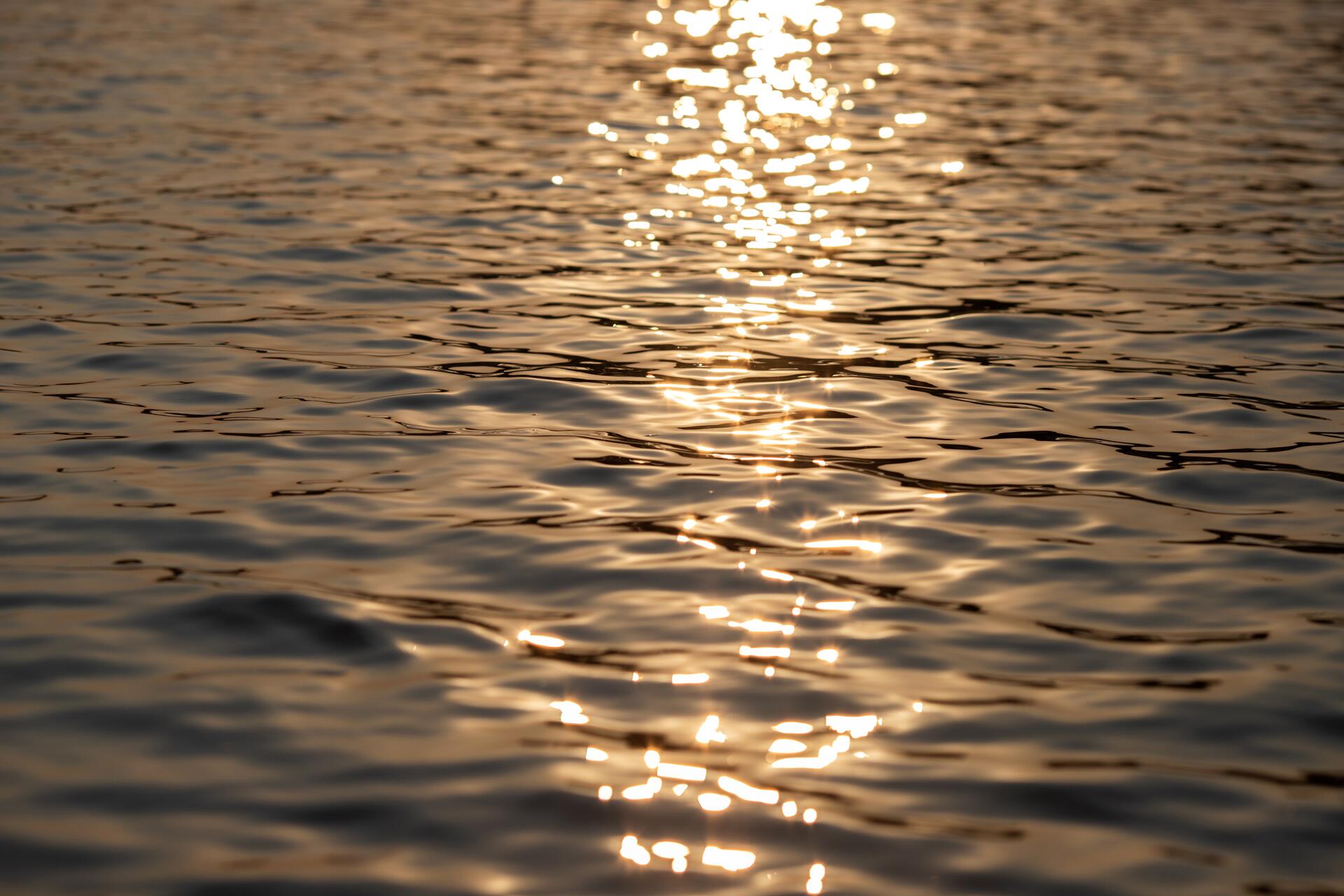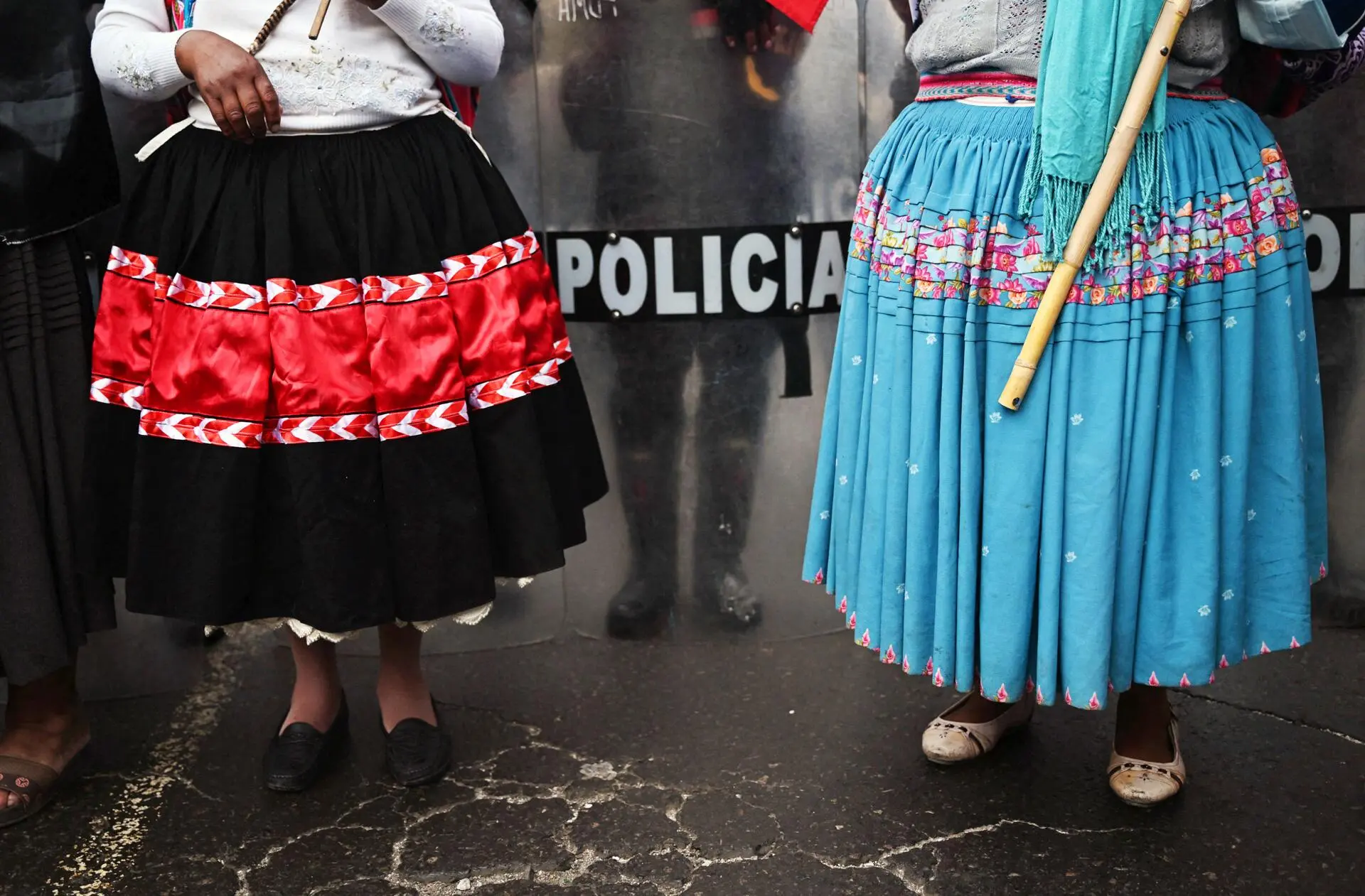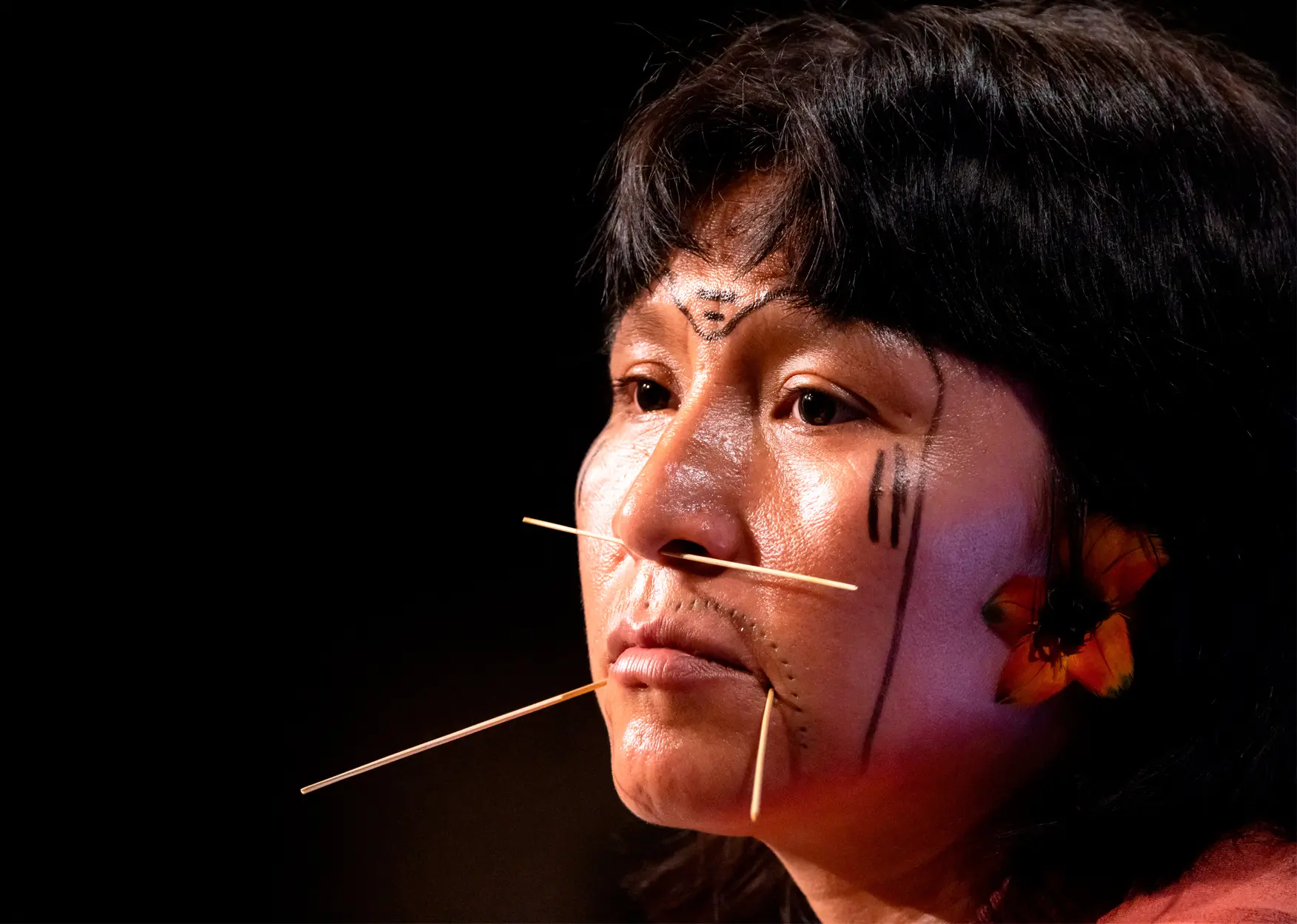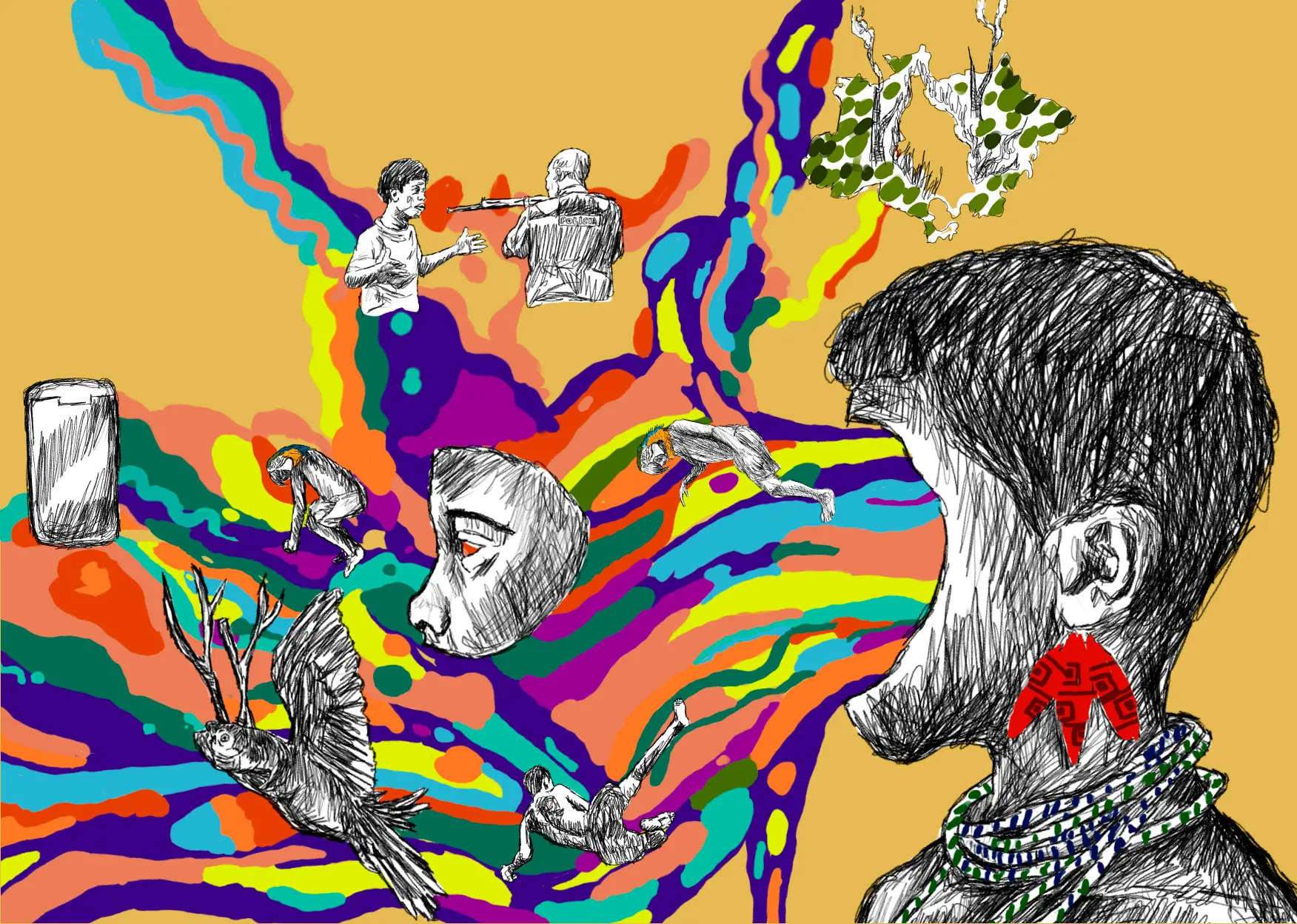“As I traveled into the jungle I began to see other young men who were like me but without the beard. Broad nose, coppery skin… I saw that, shaved and skinnier, I am an Amazonian, just like them. And I started thinking about what my life would have been like if I’d grown up there,” says Joseph Zárate, born in Lima in 1986 but descended from Amazonian stock.
Zárate is one of the very few Latin American authors with indigenous roots whose literature is gaining visibility, both in his country and internationally. Translated into several languages, he has won awards that bear the surnames of illustrious white men (Gabriel García Márquez, Ortega y Gasset) thanks to journalistic articles and books that, above all, reveal the consequences of unbridled extractivism in Peru. Timber, gold and oil are the focus of his hard-hitting book Wars of the Interior.
From one of the most dangerous countries in the world for environmental activism, his perspective reveals how we humans position ourselves in the face of environmental aggressions, and, although this has caused him to be frequently insulted and accused, among other things, of being “communist” or “leftist”, several schools have introduced his Wars of the Interior into their reading syllabus.
In March he completed a literary residency on the Costa Brava, Spain, during which he outlined an essay to be published by the Centre de Cultura Contemporània de Barcelona as part of a major exhibition dedicated to the Amazon. “It’s an introspective journey,” he says. “I start by wondering what the river has to do with me. And what is it that draws me into the jungle, to relate the lives of the people who live there”.
Joseph Zárathe: As a journalist, I guess it’s the duty to narrate that space… but there is also an existential need. I feel an urge to tell people what is happening outside the big cities, and even more so in the jungle. This is because of my maternal grandmother. She was born in the indigenous community of Vistoso, which she left as a baby because the village was flooded. The family lived first in Iquitos, then in Pucallpa, and then came to Lima. My grandmother wanted to be a nurse but ended up working as a maid. At the age of fifteen she married my grandfather, who was ten years older. He promised he would take her back to the jungle. That never happened. They had seven children. From the beginning, my grandmother thought she had to do something to avoid being discriminated against, so she began to adapt the way she spoke, drinking cocktails, dressing the way city people did… but of course, she wasn’t the same as them. When I became a journalist, I noticed that I was writing about people who came from the same place as my grandmother, from jungles and mountains, and that my need to tell stories from those places, which many call “the margins,” came from her.
Narrating the world distinguishes your place in it… and you discover that you have the jungle in your own home.
Starting with the kitchen. My grandmother had parties at home and would make juane, tacacho with jerky, aguaje juices. On school trips, my friends would bring chicken and fries to eat, and I would bring juane. They looked at me funny; I didn’t even think about it then, but as I got older I realized that those differences were significant. Later, when I traveled to the jungle as a cronista, or chronicler, I began to see young Amazonians who looked very much like me. How did they see me? On a recent two-month trip through the Amazon, I recognized my grandmother in the faces of the women in the jungles, and I wrote a short essay about it, the germ of something bigger I’m preparing about the Amazon.
How do you write a river?
The Amazon has twelve main tributaries, and in all of them there is a community, town or city of note. Iquitos, Leticia, Manaus, Santarém… I plan to collect stories in each of these places and then I will do a big trip that will bring them all together. Since I have already traveled the Amazon, I know where I will stop off.
Will it be a travel book?
Yes, but not just that. I am exploring processes such as documentary poetry, which works with letters, testimonies, reports… It deals a lot with the voice of others, the voices that History with a capital H does not usually record. There are the books of the New York poet and essayist Muriel Rukeyser (1913-1980), who has a poem about black miners in the United States, or Charles Reznikoff (1894-1976, American author of the book length poem Holocaust), who wrote about the Holocaust using records of the Nuremberg trials. The Chileans Jaime Pinos (Santiago do Chile, 1970, journalist and writer author of Criminal, Almanaque and Documental) and Carlos Soto Román (Valparaíso, 1977, poet, translator and author of 11) do the same with testimonies and documents of the Pinochet dictatorship. In Peru, this has been worked on by Tulio Mora (1948-2019), in Cementerio General, or Paul Guillén (Ica, 1976) in Sisma. I’m interested in exploring that way, subtly giving people a voice, with a poetic impulse but without giving up the strength of data and historical memory. They say that journalism gives a voice to the voiceless, but this is not true: the indigenous people, the peasants, the workers have always had a voice, but nobody listened. I aspire to dilute myself enough so that the voice of others come through as clearly as possible.
Who are the others?
I think the new approach is about diversifying perspectives. I am the author of the text, yes, but at the same time I try to make sure the perspective is no longer just mine. I would like the genre of Latin American Crónica to encourage other ways of seeing the world. Reading more chronicles by black people, by people from indigenous communities, by gender diverse authors… That is not happening. Although now these texts are more possible because languages beyond the written word are being used, in which the word takes another form, has other containers and other vehicles for dissemination. For this reason, I believe that the hegemony of the Anglo-Saxon perspective will gradually be broken. As my friend Pere Ortín says, it is necessary to do journalisms, in the plural. We must start to break down the wall of classical journalism.
Mario Vargas Llosa has announced his retirement. What does this mean for a Peruvian writer?
There are two Vargas Llosas: one whom I admire, the author of masterpieces such as The City and the Dogs, The War at the End of the World and Conversation in the Cathedral… and the other Vargas Llosa clearly linked to the more conservative right. It is very difficult to love both.
Who do you ‘love’?
José María Arguedas (1911-1969, Peruvian writer and anthropologist author of, among others, Deep Rivers) influenced me. He carried out a profound examination of Indigenismo, of the link between the peasants and the Andes, and the violence to which they were subjected through the exploitation of labor and land. Drums for Rancas, by Manuel Scorza, tells the story of the rebellion against the mining company Cerro de Pasco Corporation. Among magazines, in Etiqueta Verde you could find stories about ecology. The Peruvian writer Ernesto Ráez (1936-2021) , for example, talked about spiders as well as about a trip to a place plundered by illegal mining or the use of plastic straws. He was very good. Today I really like the work of Santiago Wills, a Colombian who writes extraordinary chronicles about animals and plants… the non-human world.
Which books help you tell the story of the jungle?
When you look for literature about traveling in the Amazon, you find mostly stories by European, English or American explorers… almost nothing by South Americans. And even less from authors with indigenous roots. There are also the writings of the early chroniclers, the colonizers who came in search of gold or cinnamon… I am interested in what the West did with these lands, how the clash with Western culture has been transforming everything.
How do you tell the story of this transformation?
They tell us there were boom periods for timber, rubber, oil, hydroelectric plants… now there are carbon credits. But for the indigenous peoples, these were periods of destruction. I want to show how these “booms” have been changing the face of the Amazon. And, at the same time, how the Amazon is inhabited by the non-human. There, a tree is not only a biological being, but an independent being, a non-human person. I am interested in telling the story of this non-human person that is the river. Treat it as a being.

Writing a river: ‘I will collect stories in each of these places and do a big trip that will bring them all together’. Photo: Ahmad Jarrah/SUMAÚMA
In literature, who has approached the Amazon in this way?
I have read texts by adventurers, semi-scientific inventories, but none of them provide that spiritual approach. Although mine still needs to be done. I’m a mixture of nervous and embarrassed to talk about something I haven’t even written yet.
You are validated by other books you have published.
Maybe, but I’m just a guy from the city, who has kept the connection with the Amazon thanks to my grandmother.
And your trips through the jungle.
Well, yes. To understand that I could have been one of those people… Anyway, I share their feeling, of having lived in what we call “the margins”. I have spent almost my entire life in the neighborhood of San Martin de Porres, one of the 43 districts of Lima, although tourists only know three. What happens in the other 42? The insecurity in these neighborhoods is similar to that of some areas in the jungle. I myself have lived through experiences of racial discrimination and I understand how an Amazonian feels when he is discriminated against because of his features or skin color.
As you pointed out earlier, it is very difficult to find books written by indigenous authors.
In Peru, it is very difficult for books written by indigenous authors to reach large audiences. There is no impetus from the cultural industries and the State to value literature in languages other than Spanish. There is a lot of racism in this omission. Also because much of that literature is oral and is looked down on, seen as inferior. Fortunately, that is changing. Dina Ananco, who won the National Literature Prize in 2022 with Sanchiu, a collection of poems in her Wampis language (spoken only in the Peruvian territory), expresses herself through poetry. In Brazil, there is a stronger tradition of oral literature that becomes written. There’s Davi Kopenawa, Ailton Krenak…
What is the issue here, why are there fewer authors in Hispanic countries?
One reason is the lack of public policies to promote literature made in the regions, the jungle, the sierra. And another reason lies in how little access these communities have to formal education. Historically, indigenous peoples have been excluded from the education system. The dominant culture looks down on those who cannot read and write, and belittles their native language, when it turns out that the knowledge of these people can be much deeper, more useful and comprehensive than that of those who read and write in Spanish. If you put a philosopher from Lima with a machete in the jungle, he might not survive a month.
But times are supposed to have changed, right?
During the colonial period, the viceregal society in Peru was divided into two clearly separated and hierarchical spheres: the republic of Indios and the republic of Spaniards, the former subjected to the latter. The Indios did not have access to land ownership, and this continued to be the case after the country’s “independence”. It was not until 1979 that the Constitution introduced the possibility for illiterate persons to vote. In other words, if you could not read or write, you were not considered a full citizen. In Wars of the Interior I talk about Edwin Chota, a city electrician turned leader of an Asháninka community, because he knows how to read and write, because the Asháninkas know that was the only way to reclaim their land. In other words, everyone is well aware of the importance of formal education, but the State must help them access it.
Doesn’t it help?
Most of the South American borders coincide with the stretches where the jungle begins. For the State, the jungle often seems like no man’s land, because its presence is minimal. It is outside the walls of the republic. And the State is disinterested, does not care about protecting it.
You say that maps are instruments of power, and that is why Peru’s map experts usually work for the State. This makes it easier to make rivers, fields and mountains polluted… and to make the people who live there disappear.
OXFAM research has recorded up to 500 oil spills in Peru over the past two decades. Enormous contamination of water and the environment in which communities have been living for generations. There are powers that find it convenient that these lands are not registered on official maps. What is disturbing is that many people are more outraged to see Notre-Dame burn than they are to see a poisoned Amazon river.
But there are also protests, and very intense ones.
In Peru, more than seventy percent of social protests are caused by conflicts linked to extractivism. Indigenous activists are killed or criminalized, so when they demonstrate, they go all out. In 2009 there was a national Indigenous protest against Alan García , the former Peruvian president who died in 2019 and served two terms: 1985 to 1990 and 2006 to 2011. He was negotiating a Free Trade Agreement with the United States, with laws that violated the ancestral lands of the Awajún and Wampis. Several people died in the clashes between police and indigenous protesters.
Do you link this lack of respect with the enduring racism?
There has always been racism, only now it is more publicly talked about. Social networks have fuelled it. Indigenous communities are getting organized, and social conflicts are occurring.
We met in 2023, during the revolts against the government of Dina Boluarte. You were going to write about them.
Yes, I am also working on the murders that were committed last year in Peru. The president has allied herself with the most conservative right wing and has retaliated against those who protested against her government. There have been about fifty people killed by police and army repression, killed by bullets, metal pellets… Half of these people were from Puno, where historically the first peasant rebellions took place. I am writing a story about who those dead people were, about why and how they died. A fifteen-year-old boy was shot in the head coming out of an internet booth. A young woman passing by was shot in the belly, a brigade doctor was shot in the back… It was when I was working on this that I realized how ineffective traditional journalism is at portraying all that violence.

Protests against President Dina Boluarte in Peru in 2023: ‘Traditional journalism is not enough to portray all this violence.’ Photo: Ernesto Benavides/AFP
Gabi Martínez has written about deserts, rivers, seas, mountains, deltas and all kinds of living beings. He spent a year living with shepherds in Spain’s wooded pasturelands, and another on the island of Buda, in the last house before the sea, which will be the first to be engulfed by the waters in the coming years. After these experiences he wrote Un cambio de verdad [A True Change] and Delta. He has written 16 books and his work has been translated into ten languages. He is the driving force behind the Liternatura project, a founding member of the Caravana Negra and Lagarta Fernández Associations; of the Urban and Territorial Ecology Foundation; and co-director of the Animales Invisibles [Invisible Animals] project. In SUMAÚMA he writes for the LiterNatura space.
Editing: Eliane Brum
Photo editor: Lela Beltrão
Fact-checker: Plínio Lopes
Portuguese translation: Paulo Migliacci
With the collaboration of: Meritxell Almarza (Spanish)
English translation: Charlotte Coombe
Editorial workflow, layout and finishing: Viviane Zandonadi
Editorial director: Eliane Brum




